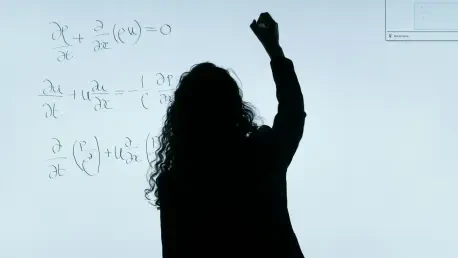Artificial Intelligence (AI) is fundamentally transforming the field of computational physics, introducing powerful new methods to solve problems that have long defied conventional approaches. At the heart of this seismic shift are physics-informed neural networks (PINNs), a sophisticated blend of machine learning and fundamental physical principles that promise to redefine scientific discovery. These innovative tools are not merely crunching numbers; they are embedding the very laws of nature into their algorithms, ensuring solutions that are both accurate and grounded in reality. From unraveling the intricacies of fluid dynamics to probing the mysteries of spacetime, AI is stepping up to challenges once deemed insurmountable. This exploration delves into the remarkable ways AI is addressing complex differential equations and inverse problems, highlighting cutting-edge advancements and their far-reaching implications. As scientific frontiers expand, the synergy between technology and physics is proving to be a catalyst for breakthroughs across disciplines like climate modeling, materials science, and astrophysics, setting the stage for a new era of understanding.
Overcoming the Barriers of Traditional Physics Computations
The realm of physics often hinges on differential equations, mathematical constructs that describe how systems change over time, from the flow of air over a wing to the gravitational pull of celestial bodies. However, many of these equations are classified as “stiff,” characterized by extreme variations in scale or sensitivity that render them notoriously difficult to solve. Traditional numerical solvers, which have been the backbone of computational physics for decades, frequently stumble under such conditions, producing results that are either unstable or painfully slow to compute. This challenge is amplified in inverse problems, where the goal is to deduce unknown parameters from observed data, a task akin to piecing together a puzzle with missing parts. The limitations of these conventional methods have historically constrained progress in critical areas, leaving scientists searching for more robust alternatives to push the boundaries of research.
AI emerges as a game-changing solution to these persistent obstacles, particularly through the application of physics-informed neural networks. Unlike traditional approaches that rely heavily on iterative calculations or oversimplified assumptions, PINNs integrate the governing physical laws directly into their learning frameworks. This means that the AI doesn’t just fit data; it respects the underlying principles of nature, resulting in solutions that are both precise and physically consistent. Such a method offers a significant leap forward, especially in scenarios where stiffness causes computational gridlock. By reframing how complex equations are tackled, AI provides a pathway to efficiency and accuracy that was previously out of reach, enabling researchers to address problems in fields as diverse as engineering and cosmology with renewed confidence and capability.
Cutting-Edge AI Techniques Transforming Physics
At the forefront of this technological wave are researchers from the Institute of Cosmos Sciences of the University of Barcelona (ICCUB), who have developed innovative strategies to enhance PINNs for physics applications. Two standout techniques, Multi-Head (MH) training and Unimodular Regularization (UR), are redefining the potential of AI in this domain. MH training empowers neural networks to learn solutions across a spectrum of related equations, fostering adaptability and reducing the risk of overfitting to specific cases. Meanwhile, UR, drawing inspiration from concepts in general relativity, introduces geometric constraints that stabilize the training process, curbing erratic behaviors that could skew results. These advancements address long-standing issues like instability, making AI a reliable tool for even the most demanding computational challenges in physics.
The real-world impact of these innovations is vividly demonstrated through rigorous testing on complex systems. From simulating combustion processes with the flame equation to analyzing nonlinear dynamics in the Van der Pol oscillator, and even tackling aspects of the Einstein Field Equations in a holographic context, the enhanced PINN framework showcases remarkable versatility. Each test case represents a step beyond what traditional solvers could achieve, proving that AI can handle problems once considered computationally infeasible. This progress isn’t confined to theoretical exercises; it lays the groundwork for practical solutions in scientific domains where precision and speed are paramount. As these techniques continue to evolve, they hold the promise of unlocking deeper insights into the fundamental workings of the universe.
Real-World Impact and Future Horizons
The implications of AI-driven physics solutions extend far beyond academic curiosity, offering transformative potential for a wide array of real-world applications. By mastering stiff differential equations and inverse problems with unprecedented accuracy, scientists can now refine predictions for climate patterns, aiding in the development of more effective environmental strategies. Similarly, the design of advanced materials benefits from simulations that pinpoint optimal properties with greater reliability. Perhaps most strikingly, applying PINNs to the Einstein Field Equations opens new avenues for exploring cosmic phenomena, shedding light on the intricate nature of spacetime itself. These advancements underscore how AI is not just solving equations but enabling a deeper grasp of the world’s most pressing scientific questions.
Looking ahead, the growing partnership between AI and traditional scientific disciplines signals a broader shift in research paradigms. Machine learning is increasingly seen as a complementary force, amplifying human ingenuity and computational power rather than standing apart from theoretical foundations. The pioneering work by the ICCUB team, bolstered by international collaboration and esteemed funding, sets a compelling example of what interdisciplinary efforts can achieve. As these frameworks mature, they are poised to become indispensable tools, accelerating discoveries in areas that remain shrouded in mystery. The journey of integrating AI with physics, which has gained significant momentum in recent years, reflects a past filled with persistent challenges met by innovative solutions, paving the way for future explorations that could redefine humanity’s understanding of the natural order.









